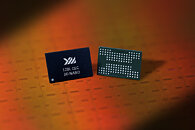- Joined
- Oct 9, 2007
- Messages
- 47,587 (7.45/day)
- Location
- Dublin, Ireland
| System Name | RBMK-1000 |
|---|---|
| Processor | AMD Ryzen 7 5700G |
| Motherboard | Gigabyte B550 AORUS Elite V2 |
| Cooling | DeepCool Gammax L240 V2 |
| Memory | 2x 16GB DDR4-3200 |
| Video Card(s) | Galax RTX 4070 Ti EX |
| Storage | Samsung 990 1TB |
| Display(s) | BenQ 1440p 60 Hz 27-inch |
| Case | Corsair Carbide 100R |
| Audio Device(s) | ASUS SupremeFX S1220A |
| Power Supply | Cooler Master MWE Gold 650W |
| Mouse | ASUS ROG Strix Impact |
| Keyboard | Gamdias Hermes E2 |
| Software | Windows 11 Pro |
Mainland Chinese semiconductor firm Yangtze Memory Technologies Co (YMTC) formally launched a product that could serve as a technological milestone for the company, a 128-layer 3D QLC NAND flash memory chip. Carrying the product naming series "X2-6070," the chip implements YMTC's XTracking 2.0 memory stacking architecture. This is a particularly big development for the company considering the chip's immediate predecessor is a 64-layer chip based on XTracking 1.0, which entered mass-production as recently as in September 2019, a time when most foreign firms such as Samsung, SK Hynix, and Micron, had moved on to 96-layer mass-production, having announced their 128-layer designs around June 2019. YMTC hence appears to have pole-vaulted 96-layer.
"With the launch of Xtacking 2.0, YMTC is now capable of building a new business ecosystem where our partners can play to their strengths and we can achieve mutually beneficial results," said Grace Gong SVP of sales and marketing at YMTC. "This product will first be applied to consumer-grade solid-state drives and will eventually be extended into enterprise-class servers and data centers in order to meet the diverse data storage needs of the 5G and AI era," Gong added. YMTC, part of the state-owned conglomerate Tsinghua Unigroup, is one of the dozens of beneficiaries of the Chinese government's initiative of localizing cutting-edge electronics technology, and reducing reliance on foreign hardware.

View at TechPowerUp Main Site | Source
"With the launch of Xtacking 2.0, YMTC is now capable of building a new business ecosystem where our partners can play to their strengths and we can achieve mutually beneficial results," said Grace Gong SVP of sales and marketing at YMTC. "This product will first be applied to consumer-grade solid-state drives and will eventually be extended into enterprise-class servers and data centers in order to meet the diverse data storage needs of the 5G and AI era," Gong added. YMTC, part of the state-owned conglomerate Tsinghua Unigroup, is one of the dozens of beneficiaries of the Chinese government's initiative of localizing cutting-edge electronics technology, and reducing reliance on foreign hardware.

View at TechPowerUp Main Site | Source
